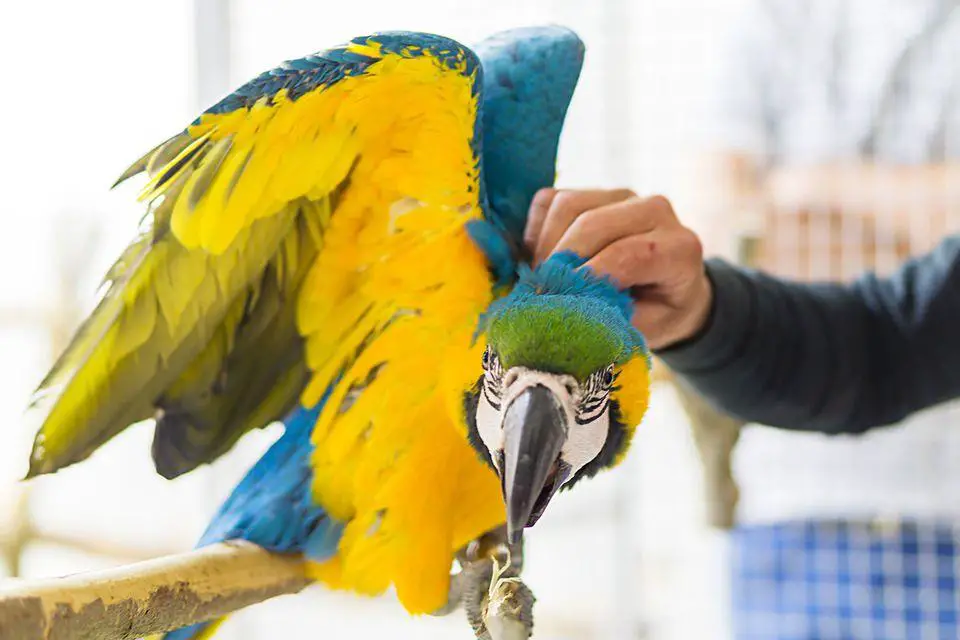The flock talk is signifying as to halt your pet parrot from screeching and motivating them to learn how to talk. Therefore, your pet parrot learns how to talk for them to gain attention by preference than in screeching. In this post, you’ll learn more about how to flock tlk when training your parrot. Let’s get started!
Basic Things to Do on How to Flock Talk When Training Parrots
1. Target Coaching
To begin, the first thing you should do is your pet parrot should learn before you teach them some tricks. Try to use the concept of implementing the action, and it follows with a receiving of treats as rewards. The most effective way to execute this is through the use of target coaching. It is an easy duty that assists the parrot to make a comprehension of what you want them to do. This essential method presents a parrot to training, adjusting them to training without any hesitation by the use of the simplest form of responsibility.
2. Session Period
When it comes to a bird that is never trying to train before a session, time may not exceed for at least five minutes in period. Once that your pet parrot is already adjusted to the theory of training to the longest period, a parrot can have a maximum time of 15 minutes every training session. If your pet parrot begins to lose its focus on what you are doing, try to take more positive exposure, then followed to end the session.

3. Positive Exposure
Don’t ever finish every training with a bad note. IN every session, it should always aim to finish with positive exposure. Because if your pet parrot could only remember that it is just tired, disoriented, and even irritating, it’s just starting to hate the training session. The possible result is that your pet might revert and reject contact, and it will make every learning idea to be unbearable.
4. Give a Rewarding Treat
Look for a reward or treats that your pet parrot will surely love – usually, the great initiative for training is food. Every parrot has a distinct preference in what food they love, so you may do some trials with a few things. Look for a treat that is not excessively fatty.
Most of the parrots can usually get overweight, and if they are just performing the same gesture repeatedly while they are getting fed, they can be gaining an unhealthy mass. The sunflower seed that is known to be as fatty treats should be chopped for at least in smaller amounts if used as a treat to your parrot. Usually, the treats must be something that your pet does not commonly get on its everyday basis. It is something that your pet parrot may really look forward to having one.
Here are some examples of perfect treats that parrots love:
- Chopped pine nuts
- Sunflower seed
- Millet or a cereal grasses
- Pumpkin seeds
- Walnuts
- Banana chips
- Or any other dehydrated fruits
These treats are known to be good consumption. But not all parrots like treats, every kind of bird will have a distinctive driving encouragement. Occasionally physical connection or toys for them to play are more favorable to your pet other than a food reward would be. If you observe that your pet is losing its determination for a food treats trials with tangible reinforcement. Good tangible examples may include hair, clothes, toys, excited noises, being pet, heightened energy, and even bouncing up and down.
Place Where to Train Your Pet
When it comes to a place where you train your pet, it is a decisive matter. Avoid any kind of interruption while you have training. Look for an area that is quiet, and it is even away from the people as well as in some animals with no open windows.
The parrot can be simply diverted by something that is flying through a window, especially when it sees its own reflection from it, so it is better to keep those mirrors covered. Also, make sure that there is no music that plays during training or even any different background disturbances that make a lot easier for a parrot to avoid you and lose interest when it comes to training.
Expressions
A loud sound or a voice signal that crosses over the space that is within the language barriers that permits you to understand each other better with your pet. The usual form of words for these are the word good or the click that comes from a clicker thing that used for training parrots.
The sound that is matched with reinforcement to specify that the sound is even to the right gesture. The right usage of the clicker is as soon as the right action is already done; it is immediately followed with a food reward or a treat.
Prompt Word
It is usually a word or a sound that always use as an alternative to a physical signal. An instance for these is maybe just saying spin to make your pet parrot turn around rather than making a circle gesture with the use of your hand.
Trigger words assist the pet owner in working with the use of physical signs to make it even more evidence of what you may want to show. If you are randomly fluttering your hand around and it is much harder to tell what you want to show against having a well-ordered word indicator that assists them to get the point that you want your pet bird to do something.
Here are some helpful tips for a successful training session:
Video Source: Youtube
- Pick out training – it is like a calming, clicker recalling, and it is great to begin every trick.
- Go up – it is for readily jumping on your hand.
- Tunnel – make tracks through a small tube.
- Laid down – resting with their backs over your hand.
- Harness coaching – these are preferring on how to confidently wear a harness.
- Hole in one – your pet may descend down into your hand that makes an “O” shaped.
- Syringe teaching – this is regarding teach them to take their medications.
- Kiss – also known as biting some object.
- Dropping it – freeing an object with a signal.
- Looping – revolving vertically around on the perch of the parrot.
- Ringing a bell – when you are shaking a bell, this will assist you to stop the attention of screaming.
- Reinforcing your bird up – secured to motivate your pet to step up in you sincerely.
- Basketball – simply shooting a ball through a hoop.
- High five – bouncing off your hand with it.
- Fetching – recovering an object.
- Verbal signs – saying a trick using voice instructions.
- Waving – raising its one foot.
Conclusion
Now you are more confident to train your parrot. Learning how to flock talk when training your parrot will help you provide the best training experience without breaking the trust between you and your pet. Most of all, you become more communicating with your pet parrot to show your tender loving care through flock talking.



